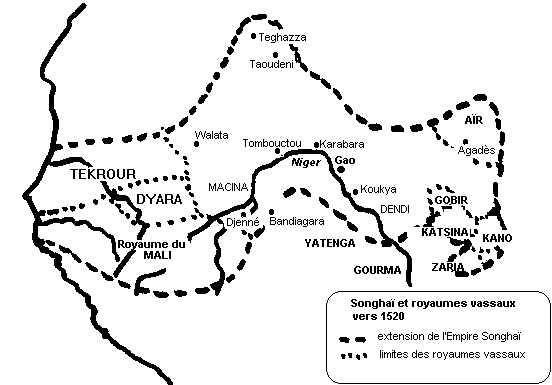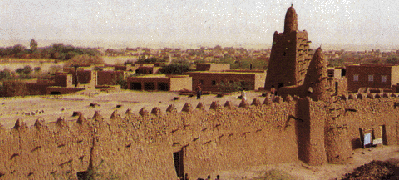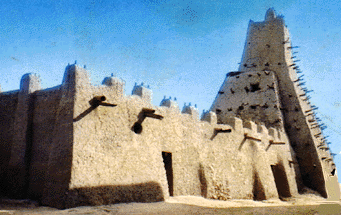
Article by Maunfu 9

In their annals the people of the orient told of the voyage of the prince, They noted their amazement at the power of his empire, but they did not depict Kankan Mussa as an open handed, magnanimous individual. For, in fact, despite the extent of his holdings, he gave alms in the 2 holy cities only the sum of twenty thousand pieces of gold, whereas [ previous Mali Emperor ] Askia-El-Hajj-Mohammed bestowed upon them one hundred thousand pieces of gold.
....[ Askia Mohammed ] made a celebrated pilgrimage to Mecca, accompanied by 1,500 men ( 500 cavalry and 1,000 foot soldiers ). He took with him part of the treasure of [ previous emperor ] Sonni Ali, 300,000 gold pieces which had been stored by the preacher Amar. Upon his arrival, he gave 100,000 as alms to the cities of Mecca and Medina and purchased in Medina a mansion which was to serve as a hostel for pilgrims from the Sudan. This mansion must have been large, for the cost of maintenance came to 100,000 gold pieces.
Soni Ali, known also as Ali Ber or Ali the Great, drove out the Tuaregs who had held Timbuktu after the Mandingos from 1434 to1468. The Tuareg chief, Akil, fled to Biro (Ualata) without a fight at sight of Sonni Ali;.....Sonni Ali entered it [Timbuktu] on January 30th, 1468.....He seized all the mountain regions where the Berbers were camped, as well as Kuntaland. The conquered Berbers were assimiliated and integrated into the Black politico-administrative organization. ...For more than a thousand years, Black governors administered the border regions of Teghezza on the Tropic of Cancer, Ualata, and Aoudaghast. ...Aryan Europe during antiquity experienced the self-centered patriotism of the city-state; it experienced universality in the Church of the middle ages; it later ended with nationalism and the formation of modern national states. Black Africa was to remain at the level of that universal consciousness politically and sociologically speaking, until its encounter with the West. Then, having undergone the effects of a conquering, expansionist nationalism, it would attempt to retaliate with the same weapons; thus African nationalism would never sink to basic chauvinism: It would consist, at most, in a development of cultural, ethical, and material values which give strength to peoples and assure their survival in the present world, a liberation of the will to transformation latent in the common consciousness.
Resources of the Royalty and Nobility
The principal source of revenue for the sovereigns of Black Africa, from antiquity to modern times, from the Indian Ocean to the Atlantic, i.e. from the Nubia of Herodotus and Diodorus Siculus to the Ghana of Bakri and the Mali of Ibn Battuta and Khaldun and the Songhai of Sadi and Kati, was gold extracted from mines. According to an anecdote supplied by Herodotus, the abundance of gold in Nubia was such that even the prisoners' chains were forged of this metal. Of course, this sort of tale cannot be taken literally, nevertheless, it symbolizes an economic reality, a society in which gold seemed more prevalent than other metals. The established facts conform well enough to this legend: the etymology of Nubia is said to signify "gold". Historically, Nubia was the country from which Egypt acquired all her gold. This gold, which was always abundant during the history of the African states, was the currency essential to international trade, first with the Arab orient, then with Mediterranean Europe (Portugal, Spain ). It contributed powerfully to the economic prosperity of the country; it quite certainly meant the sovereigns did not have to overwhelm their respective peoples with taxes and tariffs.
Royal Treasury
The treasury of the sovereign thus contained both gold pieces and chunks of gold in the raw state. There were lofts containing taxes in kind such as grains and storerooms for manufactured products: Saddles, swords, harnesses, fabrics, etc. A fair share of the treasury of Sonni Ali was deposited with the cadis of Timbuktu, perhaps because the cadis due to their positions, were traditionally honest men: This treasure did indeed exist, for it was where Askia Mohammed, after his coup and his accession, found the money for his pilgrimage to Mecca.

Various Ministries
The hierarchy of offices in Songhai was inflexible. The country was
devided into provinces, cantons, villages, large cities of commercial
character such as Djenne and Timbuktu, border areas which were strongholds
such as Teghezza, Ualata, Nema, etc. A sultan or fari governed certain
provinces, as might a cha: A farba, a mondzo, or a koi governed cities of
different types and their immediate environs.
The assara-mundio was a kind of police commisioner: viz., the assara-mundio
of the city of Djenne or the city of Timbuktu.
The anfara-kuma was the traditional judge in pre-islamic times. It was a
hereditary office always held by members of the Kuma clan.
The kan-fari or kormina-fari, was a new office created by Askia Mohammed
and occupied for the first time by his own brother, Amar Komdiago, who was
tondi-farma under Ali Ber: it corresponded to a veritable viceregency with
Tendirma as its capital.
The tunkoi, kuran, and soira were subultern military positions that might
exist in a city such as Djenne.
The Djenne-koi, Bani-koi, and Kora-koi, were administrative and military
chiefs
of cities and regions; they thus had under their commnd a territorial guard.
The Guimi-koi or Gumei-koi, was the port director.
The Hi-koi was responsible for ships and smaller craft.
The Yobu-koi was in charge of the market.
The gari-tia repaired saddles.
The berbuchi-mundio, or mondzo, was the administrator in charge of the affairs
concerning Berabic Arabs.
The koira-banda mundio was a suburban administrator of a city.
The barei-koi was chief of etiquette and protocol.
The uanei-farma was the minister of property.
The sao-farma was superintendant of forests.
The lari-farma was the superintendant of waterways.
The korei-farma was in charge of affairs concerning the white minorities
inhabiting the country.
The tara-farma was the cavalry chief.
The tari-mundio was inspector of agriculture.
We will not repeat the description of official insignia and uniforms connected
with these offices. The identity of the terms designating the administrative
offices relative to the unification of this region.
No insurmountable objections are raised by supposing it would be materially impossible to govern an empire the size of Europe or administer it without a minimum of bureaucracy. It is difficult to realize that for 1500 years, the Tunkas, Mansas, and Askias [ of Africa ] simply issued verbal orders and got verbal accounts and reports in return. The customs activities of the border areas, based on [ an earlier part of the book ] would presuppose some precise form of accounting, just as the payment of taxes and other fees would seem to imply the issuing of receipts, especially to the peripatetic merchants at the markets of Timbuktu, Djenne etc. The same held true with regard to relations of all sorts between the central authority and the various provinces, to allow administrative coordination. We shall see in chapter VII, that writing had already been a part of daily life and that intellectual activity had reached a level barely conjecturable today. Epistolary correspondence was common: When Askia Mussa came to power, he wrote 2 letters, one to his brother Otsman, the other to the latter's mother, so as to avoid any eventual conflict. The Askias who thus carried on private correspondence, did as much on the administrative and political levels. Sadi and Kati allow us to be sure of it. The concept of documentation and records clearly existed in the people's consciousness: The author of Tarikh es Sudan stresses that he saw the original of the document addressed by the Sultan of Morocco to Askia Ishaq II, concerning the salt mines of Teghezza. It was customary to accompany these missives with some token of authenticity, if they did not bear an inimitable seal: Thus , when the Timbuktu-Koi decided to open the gates of the city to Sonni Ali, he made sure to send one of his boots with the messanger so that sonny Ali might have proof of the authenticity and sincerity of the mission. The existence of African archives will be discussed further when we discuss education and child rearing.
Military Organization
In Mali and Songhai, we know for certain, the king who appointed the generals was himself commander-in-chief of the army and personally directed military operations, .... In each kingdom, each nation, the army was devided into several corps assigned to the defense of various provinces, although under command of the civil authority. Thus, each provincial governor had at his disposal a part of this army to which he could assign tasks under the orders of a general whose powers were purely military. On the lower level, below the king, in political or administrative affairs, the distinction between civil and military powers was thus very clear. The king of Mali, when he conquered Songhai, Timbuktu, Zagha, Mima, the Baghena, and the environs of that region as far as the Atlantic Ocean, had 2 generals under his command. One was responsible for the defense of the southern part of the empire, on the Mossi border, the other of the northern part at the edge of the desert. Their respective names were Sankar-Zuma and Faran-Sura.
These were the titles corresponding to their military functions. Each of them had under his command a certain number of officers and troops. The western borders of the state of Djenne, before the conquest of the city by Sonni Ali, were defended by the commanders of 12 army corps deployed in the country of Sana: They were specifically assigned to surveillance of the movements of Mali. The Sana-faran was their general-in-chief. ....In Songhai, beginning with the reign of Askia Mohammed, a distinction began to be made between the people and the army. Instead of mass conscripton, a permanent army was created; civilians who were not part of it could go about their business. During the reign of Sonni Ali, all able-bodied nationals were subject to enlistment. The major divisions of the army were : knights, cavalry, foot soldiers, auxilliary bodies of Tuaregs, elite infantry regiments, the royal guard, and an armed flotilla.
The University
.....The mosque was at one and the same time also the place of learning., the university. It was not an official building, but the religious undertaking of a devout cadi, apparently helped, in the beginning at least, by the people. Thus, Cadi El Aquib restored the mosque built by Mohammed Naddi, the work being finished between July 16 and August 14, 1569. The Great Mosque of Timbuktu long remained unfinished, until Askia Daud, passing through the town, undertoook to assist the Cadi, saying to him: "What remains to be done, I shall take upon myself: it will be my share in this pious endeavor." The schedule of courses lasted all day, interrupted only at times of prayers. Some scholars even taught for part of the night. Immediately following prayers, the students gathered around the professor, who imparted his teaching, commented upon the texts, and discussed them with the students. These professors were not officially paid: they taught for the love of teaching; in return, they enjoyed immense respect and gratitude from their pupils (learning the Koran) and their more advanced students who, after mastering the Koran, went on to the various branches of Higher Education. On Wednesday, the day off from school, pupils and students each brought him some honorarium, for him to live on. According to Kati, in Timbuktu, there were 150 to 180 Koran schools.

The Program
....The intellectual tradition was already well established at the time of Sadi (sixteenth century). About Mohammed Ben Mahmud, he writes: "He made a commentary of El Moghili's poem in Redjez on logic. My father studied rhetoric and logic under him. He died in the month of Safar in 973 [ September 1565]. Sadi himself studied all these subjects, and commented on several texts; he was the pupil of an inhabitant of Timbukltu, a scholar of Uankori origin, by the name of Mohammed Ben Mahmud Ben Abu Bekr.
" In a word, he was my professor, my master, and no one was more useful to me, whether directly or through his writings.... He awarded me graduate diplomas written in his own hand, covering the subjects he had taught according to his own works; he wrote on them annotations quite flattering to me; he even reproduced the results of some of my research and I heard him quote some of them in his lectures, thus displaying his impartiality, his modesty, and his respect for the truth in all circumstances. He was with us at the time of our misfortune. "
Al-Hasan ben Muhammad al-wazzan az-Zayati by his real name, but baptized as Johannes Leo de Medicis ( Giovanni Leone e author of a valuable description of parts of the Western Sudan, notably along the lower reaches of the middle Niger, drawn from personal travels as a merchant there wearly in the sixteenth century. Its Italian publication in 1550 (by Ramusio) aroused an interest in Western Europe somewhat comparable with Columbus' news of land beyond the Atlantic, and rapidly became the equivalent in those days of a modern bestseller.
There are in Timbuktu numerous judges, doctors [of letters] and priests [ i.e., learned Muslims]. (The ruler) greatly honors scholarship. Here too, they sell many hand-written books that arrive from Barbary [i.e., North Africa]. More profit is had from their sale than from any other merchandise. In place of minted money, they use bits of pure gold and, for small purchases, cowrie-shells: shells, that is, imported from Persia which exchange at 400 for the ducat. [Not in fact, from Persia, but from the Maldive Islands in the Indian Ocean; a ducat in Leo's account was the mitqual of the North and West African long-distance trade, and weighed four grams 238.]